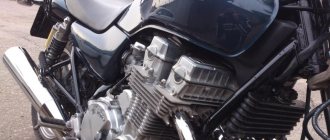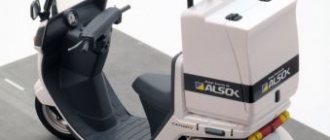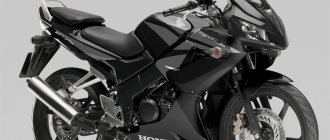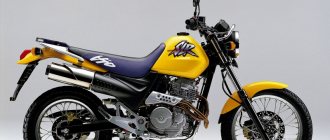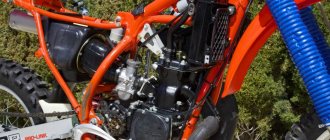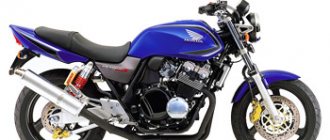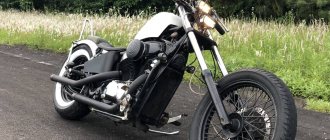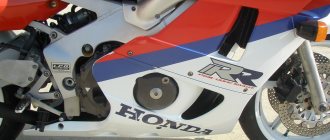People started talking about the Honda CB 750 motorcycle back in 1969 . In 1981, he received a rebirth, as a response to the release of the Zephyr 750 . another Japanese manufacturer - Kawasaki.
The CB 750 was produced until 2003 and had two official modifications. It gained its popularity due to the qualities inherent in the concern, as well as its simple design, which allows bikers to assemble their own custom versions.
The model belonged to road workers and allowed a classic landing. To expand the sales market, it was produced in several sizes, allowing any biker to choose the device for himself.
Specifications
An interesting solution for the engine was the installation of hydraulic compensators, thanks to which there was no need to adjust the valves.
Engine – right side view.
Engine – left view.
Otherwise it was a standard 4-cylinder, 4-stroke engine .
- working volume - 747 cm3;
- power - 75 hp;
- number of valves - 16;
- cylinders - 4;
- cooling - air-oil;
- fuel supply - carburetor (Keihin 34 mm);
- ignition - transistor;
- start - electric starter;
- fuel tank - 20 l.
To comply with the new legislative framework, Japanese models received a redesign in 2001, but the developers did not “strangle” the engine. The bike for the domestic market was equipped with a different frame model, a modified exhaust system and different carburetors. The redesign turned out to be so successful that the new bike could be purchased in Japanese markets until 2008 .
Transmission and clutch
The motorcycle transmission is based on a classic chain drive.
The motorcycle received a 5-speed gearbox.
According to users, the box is not bad, but the gear ratios do not provide fast dynamics, and in most cases, engaging the 5th stage is impossible.
The developers noticed that the bike is not a city bike, but a road bike . And when driving on the highway, dynamics are far from the first place in the line of qualities.
- Multi-disc clutch, oil bath . The transmission of power depended on the specific motorcycle. Both hydraulic and standard cable solutions were produced.
- Main drive - chain.
Brakes
Depending on the modifications, the bike's brakes also had different designs. From 2-disc hydraulics on the front axle to drums on the rear. Therefore, the list will have two values, for both official modifications.
Front double disc brakes.
Rear disc brakes.
Front: brakes:
- number of disks - 2 (1);
- diameter - 296 mm;
- support - 2 (1) piston.
Rear brakes:
- number of disks - 1;
- diameter - 240 mm;
- support - 1-piston, or drum design.
No options were offered for either model.
text from MotoReview
Honda CB750: 747 cc, 75 hp, 215 kg, $3800
There are some motorcycles that seem to exist outside of time. They are completely unaffected by bursts of fashion and technological innovations. For many generations of motorcyclists they were, are and will be. A good example of this is the Honda CB750. Everyone knows this model, the number of copies produced has long exceeded hundreds of thousands, its abbreviation emphasizes the glorious history of this name - one of the most significant motorcycles of the 1970s. Honda's first four-cylinder motorcycle appeared in 1968 and revolutionized the market. He set completely new standards and changed attitudes towards recreational models. The car had an overhead camshaft, a five-speed transmission and a front disc brake. Many believe that the CB750 should be considered the first true supermotorcycle.
It was to cement this event in the annals of history that 17 years later, in the early 90s, Honda again decided to launch a similar classic car into circulation. And, despite the fact that many tried and are trying to consider it as some kind of competitor to local and modern neoclassics, Honda designers have always emphasized that they deliberately aged the “stuffing” and chassis, thereby distinguishing the model from the wide mass of similar two-wheeled remakes. The appearance of the SV750 and its characteristics determine the special place of the car in the modern table of ranks. Since its debut in 1991, several modifications have been released. The most common are the CB750 Nighthawk (with a single-disc front brake, smoother fascia shapes and large-spoke alloy wheels) and the classic CB750 with chrome mufflers, dual-disc front brakes and a rear passenger handle. Accordingly, there were differences in weight, gas tank volumes and dimensions. However, the simplified American version did not last long on the assembly line, and since 1993 it was completely replaced by the classic version, which, by the way, also began to be produced in fairly large quantities in a special modification for motorcycle schools. The devices are distinguished by black mufflers, the absence of a passenger handle, and sometimes an additional fan on the oil radiator.
Otherwise, the CB750 is “tailored” according to the classic proven design – a duplex frame, a four-cylinder in-line engine, a “telescope” in the front and two shock absorbers in the rear, simple disc brakes and the same “tidy” with a round headlight.
Thanks to its huge circulation, reliability and unpretentiousness (it is no coincidence that it is used in Japan as a motorcycle for training!) the model has long been a regular at second-hand stores. Given the combination of characteristics and availability of spare parts, the price is quite acceptable for many. And it is not surprising that the device is most often preferred in our country as the first foreign car. Even with a good mileage of 50,000 km, it is capable of running at least that much. Not every contemporary can survive this long. That's why we decided to take a little break from the new products and return to the classics of the genre. How are you, “grandmother”?
Vladimir Zdorov, Motor Review expert Height - 193 cm, driving experience - 13 years, rides a Suzuki TL1000R sportbike. For some unknown reason, instead of a well-deserved place in the museum of motor rarities, this device stands in front of me and looks in surprise with the round headlight of the “correct” one. classic design to the modern world, which has changed so much over the many decades since its inception. Long years of hard work in a previous life as a tool for a motorcycle courier or the first motorcycle for training in various motorcycle schools only confirm its legendary reliability and unpretentiousness. However, it is precisely this circumstance that makes me very suspicious of those devices that end up on the secondary market. It’s even scary to imagine how many laps their unfortunate odometers have clocked up...
To some extent, the “sibikha” was a victim of its own successful and indestructible design. Of course, trying to seriously evaluate the performance of suspensions, brakes or handling from the standpoint of the capabilities of a modern motorcycle would, to put it mildly, not be entirely correct in relation to the “old lady”. However, there is no escaping the immutable facts either. For example, in terms of ergonomics, this “grandmother” is able to give master class lessons to many of her contemporaries - the seating position is absolutely relaxed, there is a decent amount of legroom, the “classics of instrumentation” in the form of two indispensable “glasses” of a speedometer and tachometer are right before your eyes, respectively, providing excellent readability. The clutch and brake levers please with little effort, and the reliability and precise operation of the gearbox, which has already become the talk of the town, is taken for granted when choosing a motorcycle with the Honda inscription on the gas tank. At the same time, the seat itself pleases with both its size and thickness, providing a completely digestible level of comfort for both the owner and his possible passenger, and it does not matter what build he is.
SV750 is a motorcycle of mood and understanding of life in its beautiful manifestations a good 20 years ago. It is also interesting that if you set a goal and, suppressing the urges of pity, mercilessly unscrew the throttle in first gear, not forgetting, of course, to “spit” the clutch, then the engine will sway and squeak indignantly with a couple of “backpack” shock absorbers at the rear , is quite capable of covering 50 meters on the rear wheel, rewarding him with a severe fork breakdown on landing for such a disrespectful attitude towards age.
Riding “on the knee” is also possible here, however, the motorcycle resists and wriggles in every possible way, like a creeping reptile, clearly hinting that they don’t ride classics like that. You must understand that you need to look for pure adrenaline and fun when riding this motorcycle, not in acceleration or refined work of suspensions and brakes, but directly in the process of movement and movement in space and time, and that feeling of freedom that no car is able to reward its owner, no matter how many zeros appear in his price tag. If we are honest with ourselves, we must admit that due to the specifics of the work, the body, as they say, has “eaten” with various “motor delicacies”, which does not always allow us to accurately and impartially assess the merits of some motorcycles, the whole point of which is not at all in clever injections or high-tech frame made from alloys of high-mountain goat excrement.
The main advantage of this Honda, it seems to me, is its accessibility and simplicity of design, which in further operation will ensure minimal maintenance costs. In theory, the main concept of this model involves significant daily mileage, it doesn’t matter whether the motorcycle is used for some work purposes, or we are talking about a large motorcycle trip - the essence is the same, the owner of the SV750 will always be as convenient and comfortable as possible, and his head will not be clogged thoughts about why the third gear “does not engage” and the second constantly “knocks out”. Or where to get motorcycle oil to top up the engine; this is unacceptable bad manners for the Honda Corporation. In general, if you need a motorcycle as a vehicle, where reliability and unpretentiousness are at the forefront, then the Honda CB750 seems to me to be a completely worthy and interesting option, the main thing is to be able to find a copy that has not been tortured to the point of clinical death.
Nikolay Bogomolov, Motor Review expert Height – 183 cm, driving experience – 8 years, rides a Kawasaki KDX250 Once upon a time, almost 40 years ago, this motorcycle revolutionized the market. Since then, a lot of water has flown under the bridge, contemporaneous models have sunk into oblivion, but the Honda people continued to rivet the best-selling classic. I really wanted to find out what the trick of the motorcycle is that attracts many millions of buyers, so I started testing with particular enthusiasm.
There were no complaints about the landing. Almost without getting out of the saddle, I rode several hundred kilometers and did not feel tired. The “fifth point” normally perceives contact with a comfortable seat; there is no discomfort in the limbs located on the steering wheel and footrests. The rear road conditions can be clearly read in the mirrors, especially since there are no vibrations. In general, I would not be afraid to go long distance on this motorcycle. However, there is not enough protection from the wind. But if you want to spoil the motorcycle for the sake of comfort, you can put a tuning windshield on it. But the device has problems with dynamics. You don’t get any “kicks in the butt” by “opening the handle”: smoothly and relatively slowly the CB accelerates to about 160 km/h, after which it becomes completely sluggish. In a word, it is not conducive to aggressive driving. The suspension is not conducive to this either. When cornering at speed, the front wheel does not behave entirely predictably - it follows its own trajectory. But if you don’t pretend to be Valentino Rossi, you can ride. Moreover, on small uneven surfaces the suspension absorbs almost all shocks, keeping the rider’s musculoskeletal system safe and sound.
The brakes match the character of the bike. It would be hard to call them powerful, but they are enough for braking during quiet driving.
Having listened to my experienced comrades, I filled the tank with 92-grade gasoline. And indeed, the motorcycle rides no worse than the 95. Consumption during dynamic city driving is five to six liters, when driving on the highway it is slightly less. What is the specialty of the motorcycle? This is what I couldn’t understand. A faceless device with average performance for reasonable money. Apparently, this is exactly the kind of car that most buyers need. It’s not for nothing that Zhiguli and Golf cars sell best on the automobile market.
Mikhail Lapshin, deputy editor-in-chief of Motorreview Height - 193 cm, driving experience - 12 years, rides a Yamaha TDM900 and Yamaha YBR125 Inspecting the motorcycle on site made me sad: the mufflers are black, which means the device is from a Japanese motorcycle school, brake discs and calipers “breathe time”... I can imagine how many people have ridden on it! But, lo and behold! The engine runs completely smoothly, responds easily to the gas, the suspension does not leak, and the gears engage like on a new Yamaha - normally. Okay, I persuaded you, “old lady,” let’s go!
How can I convey these sensations more precisely?.. Have you ever ridden a Volga? Here the impressions are approximately the same: a slight swing on uneven surfaces (the suspensions just need time to dampen the flaws), as if there is traction (well, in the sense that the engine pulls and accelerates the car), and even controllability is present (on a straight line, mostly) . I admit, I immediately felt completely out of place in the modern equipment and integral helmet on the SV750. I just wanted to dress in an open bowler hat, canned glasses, leggings and army boots. This device seemed to have fallen out of the times when “Java”, “Izhi” and “Dnepr” were moving on our roads.
I did not evaluate the motorcycle from a modern point of view. Crazy blows, turns with “knees”... if our Vova Zdorov amuses you with this, then the flag is in his hands. The device was created simply for moving from point A to point B. The rhythm is unhurried - 120 km/h is best. The trajectory in the flow does not need to be too confusing. Remember, straight forward is best. And don't assume that these impressive-looking brake discs slow the car down with the capabilities of modern motorcycles. Just know that they work well, but without a single drop of sport. The heavy weight of the “Sibihi” makes itself felt in turns, when the rear begins to merrily rearrange, and the front wheel moves away from the line intended by the pilot. In such cases, it is better to simply let the car level itself and drive along a trajectory known only to it.
After clocking up about 300 km on the odometer, I finally understood what the aura of this motorcycle was. You need to be as simple and undemanding as possible with him, just love him for what he is, and for the fact that he has a very well-deserved pedigree behind him. Yes, yes, the most family relationships, a real “grandmother”! Don't you sometimes love to sit with your elderly relatives, chat, listen to interesting stories and talk about life? What about ambitions? Leave them at the door...
Alexander Astapov, Deputy Editor-in-Chief of Motor Review Height – 182 cm, driving experience – 15 years, drives an Italjet Dragster XX An old, old joke. The New Russian is returning Christmas tree decorations to the store. They ask him: are they really defective, so we will replace them for you right away, etc. He shakes his head. Having tired of fluttering around the client, the sellers ask in despair: “So what’s the matter?” He looks sadly: “They don’t make me happy...”. I’m also not happy with this “sibiga”. Everything seems to be in order (if, of course, we ignore the nightmare state of this specimen): comfortable fit, soft saddle, quite efficient brakes, quite (enough, fellow sport bikers!) powerful engine...
But all the same: it’s not happy! On the way to work and back, I want to enjoy driving, and not just move from point A to point B. I didn’t find any “spiciness” or any kind of sharpness in any reactions at all. Everything is boring, like your spouse’s grievances after another night you spent away from home. Not happy... And the device weighs - dear mother! Yes, liter neoclassics are even heavier, but there you understand why you are straining your tired muscles and broken joints. I’ll keep silent about the Sportster: there you feel like a rider of a wild “steel horse” living its own life, and at least it brings pleasure. Everything here is sluggish and tasteless. Not happy...
And the appearance is a nightmare. Yes, it seems like everything is in the style of its 400 and 1000 cc counterparts. But everything is quite harmonious with them. Here the proportions are different, and I, looking at the motorcycle from the side, feel the desire to turn away so as not to spoil the mood with the sight of this bastard. The Nighthawk version - although it had no brakes (one disc in front and a drum in the rear for such a carcass - tears!), but its noble appearance made it a good alternative to the old Japanese cruisers. And this one... I’m not happy! So, “get this bastard out of sight.” I will never take it for myself, even if there is an option in mint condition for ridiculous money. He doesn’t make me happy, he doesn’t make me happy!
Alexander Dmitriev, editor-in-chief of “Motoreview” Height – 183 cm, driving experience – 16 years, drives a BMW F650 GS I have a long-standing relationship with the SV750, and it’s platonic. So, without ever having ridden it, in 1996 I almost bought this motorcycle. And I liked his appearance. Instead of the Seabikha, I bought an enduro and forgot about the SV for five years. Then the fanaticism passed, and somehow I just took the SV750 for a ride. I rode it a bit, realized that the device was too small for me, and changed it to a CB1000. Therefore, now I rode this legendary motorcycle for almost the first time. Strange, but today he no longer seemed very small to me. Well, the saddle is a little low, but it’s more comfortable to place your feet on the ground. How does the motor work? This is one of those motorcycles that, with your eyes closed, you can tell it's a Honda. Riding a motorcycle is pleasant: but not in a hurry. At the same time, it allows decent maneuvering in traffic, easily accelerates, brakes and does everything that a regular motorcycle should do. You don’t expect gun-like dynamics and precise handling from it. But he can drive for a long time and with minimal investment. No one looks at the SV750 as if it were an expensive thing - it does not attract crowds of onlookers. And this is again nice - it reduces the likelihood of theft. I rode it to the dacha - no one noticed that I had arrived on a motorcycle. The CB750 does everything correctly and predictably - whether driving on the highway or broken concrete. But you won’t get what’s called fun from him. If only while traveling. By the way, about long trips: I drove it about 180 km in one sitting, and assessed the condition of the “fifth point” as good. But you won’t be able to travel with a passenger – the suspension for two is still a bit soft. And one can only guess how he will behave laden.
And what about the notorious price-quality ratio? What can you buy for $3500? The only one with a 750 cm3 engine is the Kawasaki Zephyr 750. But can you compare it with a Honda? What about the choice of additional equipment? A motorcycle produced in huge quantities is loved by spare parts dealers: at least consumables are always available for it.
The summary is this: an excellent motorcycle for those who do not care about image, but just need to ride. Travel a lot with minimal hassle and expense. Yes, and you can learn from it - decide to resell it in a year - you won’t lose anything in money.
Driving performance
The 750 cc Sibiha is a balanced road bike, as simple and durable as possible.
The maximum declared speed is 205 km/h . As a result of changes in 2001, Japanese ones gave 180 km/h . According to users, this can be squeezed out, but the absence of a windshield will create problems.
Acceleration to hundreds
Acceleration from zero to 100 km will give a head start to many sports cars - 3.9 seconds.
But users note that although the result is impressive, the bike’s character is calm and this also affects the acceleration dynamics.
Fuel consumption
Fuel consumption depends on the cycle of use, road, driving style. You can’t count on less than 6 liters per 100 km
Honda CB 750 review
The mid-sized CB 750 road bike was designed as an alternative to the underpowered Honda CB 400 and the overweight Honda CB 1300 with excellent durability and simplicity. The CB 750 is a remake of one of the most popular motorcycles of the 70s, and the manufacturer admitted that it deliberately created the second generation with an archaic design.
The Honda CB 750 was not created as a competitor to its classmates - rather, it was a model created for those who want to buy a motorcycle built on the basis of old technologies. The idea of the Japanese company turned out to be successful: the CB 750 was extremely popular and was produced in several versions - classic, CB 750 Nighthawk and a simpler one, used for training in motorcycle schools in Japan.
Dimensions and weight
Official modifications differed not only in internal filling, but also in external characteristics.
Weight:
- the motorcycle's dry weight was 215 kg ;
- equipped - 235 kg .
The American version had 210 kg and 226 kg respectively.
Dimensions:
10-15 mm larger . The bike had:
- length - 2,221 mm;
- width - 780 mm;
- height - 1,100 mm.
- Seat height - 795 mm.
- Wheelbase - 1,495 mm.
The Japanese got a slightly different geometry - the bike was higher in overall height, but lower in the saddle.
What else can you add about this beauty?
The fact that for true connoisseurs of technology this motorcycle model is optimal. It is time-tested, inexpensive and easy to maintain, has a rather impressive external design, and also has decent technical characteristics. Moreover, with its current capabilities, a motorcycle can easily be equipped with all sorts of attributes that will provide it with an even longer service life. Moreover, this version is very often used in some countries (in Japan, for example) as a motorcycle for training, since due to its “indestructible” characteristics it is perfectly suited for this role. Therefore, it is not at all surprising that in our market it is in quite high demand, especially among those who have decided to switch to a foreign car for the first time. This motorcycle, even after traveling several thousand kilometers, is capable of withstanding the same amount.
For whom is it intended?
Such a bike will not attract a crowd of onlookers, but it can last for a long time and with minimal investment.
As already mentioned, the model had several solutions in order to reach the maximum possible number of willing buyers.
However, it will be most comfortable for bikers of medium and small height. Tall and broad-shouldered people will have to adjust it to suit themselves.
Honda CB 750 review
The mid-sized CB 750 road bike was designed as an alternative to the underpowered Honda CB 400 and the overweight Honda CB 1300 with excellent durability and simplicity. The CB 750 is a remake of one of the most popular motorcycles of the 70s, and the manufacturer admitted that it deliberately created the second generation with an archaic design.
The Honda CB 750 was not created as a competitor to its classmates - rather, it was a model created for those who want to buy a motorcycle built on the basis of old technologies. The idea of the Japanese company turned out to be successful: the CB 750 was extremely popular and was produced in several versions - classic, CB 750 Nighthawk and a simpler one, used for training in motorcycle schools in Japan.
Modifications
Official
European version - Honda CB 750 Seven Fifty.
The American version is the Honda CB 750 Nighthawk.
Motorcycle dealerships offered the bike in 2 versions. They had different frame models, colors and even internal fillings. They also received different names.
- Honda CB 750 Seven Fifty . Interestingly, the name translates as 750. European version. It had larger dimensions, better filling, disc brakes on both wheels, and was the first to receive new features. Since 1992, with changes in the frame design, it appears on Japanese markets, where it is sold for three (until 1995) years. Since 2001 it appears again and is released until 2008 .
- Honda CB 750 Nighthawk - American version. A more cruiser-like external body kit, has drum brakes at the rear, and 1 disc on the front wheel. Interestingly, the cruiser concept included a windshield. Another distinctive feature of the “Eagle” was the release of certain years based on a lowered Japanese frame. A break in production in 1994 .
Custom:
Very often a motorcycle was bought to be converted into a custom one.
Front view.
Back view.
Side view.
One of the popular solutions was cafe racer . Honda, due to its powerful engine, was an ideal option for such a conversion.
- The lack of a front body kit, already in stock, made it look like a bobber.
- Replacing the steering wheel with clip-ons, a special aerodynamic body kit, and a reduced engine volume distinguished it from the classic bobber. And changing the swingarm or tires to more practical ones for real bikers, as a rule, was not difficult.
- The best in appearance and best suited to the tasks of a custom bike in the Honda CB750 line was the RC42 - the European version of the bike.
Brief history of the model
Model:
Honda CB750 Nighthawk (North America).
Frame number:
JH2RC381MMXXXXXX.
1992 - launch of the Honda CB 750 F2 Seven Fifty modification. The model is available in Europe and Japan.
Model:
Honda CB750 Nighthawk (North America), Honda CB750 F2 Seven Fifty (Europe, Japan).
Frame number:
JH2RC381NMXXXXXX (North America), RC42XXXXXXX (Europe), RC42-100XXXX (Japan).
Model code:
CB750F2N (Europe).
1993 - European version temporarily discontinued.
Model:
Honda CB750 Nighthawk (North America), Honda CB750 F2 Seven Fifty (Japan).
Frame number:
JH2RC381NMXXXXXX (North America), RC42-100XXXX (Japan).
1994 - The American version of the Nighthawk is temporarily discontinued.
Model:
Honda CB750 F2 Seven Fifty (Japan, Europe).
Frame number:
RC42-100XXXX (Japan), RC42XXXXXXX (Europe).
Model code:
CB750F2R (Europe).
1995 - CB750 F2 Seven Fifty changes a bit. The color red appears and the rims are available in black (instead of silver).
Model:
Honda CB750 Nighthawk (North America), Honda CB750 F2 Seven Fifty (Europe, Japan).
Frame number:
JH2RC381SMXXXXXX (North America), RC42XXXXXXX (Europe), RC42-110XXXX (Japan).
Model code:
CB750F2S (Europe).
1996 - Japanese version no longer produced.
Model:
Honda CB750 Nighthawk (North America), Honda CB750 F2 Seven Fifty (Europe).
Frame number:
JH2RC381TMXXXXXX (North America), RC42XXXXXXX (Europe).
Model code:
CB750F2T (Europe).
1997 - no significant changes.
Model:
Honda CB750 Nighthawk (North America), Honda CB750 F2 Seven Fifty (Europe).
Frame number:
JH2RC381VMXXXXXX (North America), RC42XXXXXXX (Europe).
Model code:
CB750F2V (Europe).
1998 - no significant changes.
Model:
Honda CB750 Nighthawk (North America), Honda CB750 F2 Seven Fifty (Europe).
Frame number:
JH2RC381WMXXXXXX (North America), RC42XXXXXXX (Europe).
Model code:
CB750F2W (Europe).
1999 - no significant changes.
Model:
Honda CB750 Nighthawk (North America), Honda CB750 F2 Seven Fifty (Europe).
Frame number:
JH2RC381XMXXXXXX (North America), RC42XXXXXXX (Europe).
Model code:
CB750F2X (Europe).
2000 - Only the American version of the Nighthawk is available.
Model:
Honda CB750 Nighthawk (North America).
Frame number:
JH2RC381YMXXXXXX (North America).
2001 is the last year of production of the European version of the F2 Seven Fifty, and the model is again available in Japan. The bike gets a new exhaust and carburetors to meet the updated emission norms. The rear suspension is simpler, without a compensation tank. The belt on the passenger side of the seat has been removed.
Model:
Honda CB750 Nighthawk (North America), Honda CB750 F2 Seven Fifty (Europe, Japan).
Frame number:
JH2RC3811MXXXXXX (North America), RC42XXXXXXX (Europe), RC42-125XXXX (Japan).
Model code:
CB750F21 (Europe), CB750FII1 (Japan).
2002 - Only the American version is produced.
Model:
Honda CB750 Nighthawk (North America).
Frame number:
JH2RC3812MXXXXXX (North America).
2003 - no significant changes. Last year of release.
Model:
Honda CB750 Nighthawk (North America).
Frame number:
JH2RC3813MXXXXXX (North America).
2004 - The F2 Seven Fifty version begins production again, but only for the Japanese market. The model gets new colors, multi-reflector headlight, electric speedometer, electronic odometer, immobilizer (HISS) and new carburetors with throttle position sensor. The rear suspension is being changed, which again receives compensation shock absorber reservoirs.
Model:
Honda CB750 F2 Seven Fifty (Japan).
Frame number:
RC42-135XXXX.
Model code:
CB750FII4.
2006 - new colors appear.
Model:
Honda CB750 F2 Seven Fifty (Japan).
Frame number:
RC42-160XXXX.
Model code:
CB750FII6.
2007 - the appearance of a special version of the motorcycle - Honda CB750 Seven Fifty Special Edition.
Model:
Honda CB750 F2 Seven Fifty (Japan).
Frame number:
RC42-170XXXX.
Model code:
CB750FII7.
2008 is the final year of production of the Honda CB750 F2 Seven Fifty.
Model:
Honda CB750 F2 Seven Fifty (Japan).
Frame number:
RC42-171XXXX.
Model code:
CB750FII8.
Flaws
During ownership, users noted the following disadvantages.
- Brakes . The bike is heavy, maximum speed is achieved without difficulty, and the brakes are weak. We are not talking about versions for Americans at all - the drum is useless at speed.
- Reserve tap . General leakage. Finding a new problem can be treated simply by removing it and connecting directly.
- Vibrations . At medium speeds for the urban cycle, vibrations begin. There is no treatment.
The general old age of the car was separately noted. Used components, developed in the middle of the last century .
and dignity
There are more advantages.
- Reliability . Despite its obsolescence, the motorcycle is very easy to maintain and reliable.
- Cooling . As bikers say, the fewer parts a motorcycle has, the less it breaks. An air filter can be found at any auto store.
- Hydraulic compensators . The only model where you don’t need to bother with periodic checking and tightening of valves. He will do everything himself. Users recommend using a more viscous oil.
- Controllability . Ideal weight distribution made for ideal handling. And the large mass did not become a problem.
- Price . The low price is justified by the simplicity of the bike. Not every bike of this volume can cost as much as a Chinese small-capacity bike.
- Twin shock absorber at rear . Not every bike can boast of such a comfort solution.
- Fuel . 92 gasoline is enough . particular increase observed when filling 95-98 . If possible, you can adjust it to 80.
Maneuverability. Calm character, despite the heavy weight - high center of gravity, such qualities are noted when talking about this bike
Honda CB 750 design
The Honda CB 750 is the type of motorcycle that never gets old, is independent of fashion and rarely undergoes technical innovation.
- Rigidity and passenger comfort were achieved thanks to some non-standard solutions. The total result is a fast, comfortable bike that requires a minimum of maintenance, and therefore allows you to spend most of your time on it, and not under it.
- The front wheel was provided with traction by a telescopic fork, and the rear wheel was provided with a pair of shock absorbers on a pendulum basis. The diameter of the fork stays is 41 mm. The useful travel of the front axle is 130 mm, the rear - 110 mm. For user convenience, the preload force of the rear springs could be adjusted.
Rear shock absorber with reservoir on a 2001 bike.
- Non-standard solutions included drum brakes on one of the modifications, air cooling, and a change in frame geometry from model to model.
Exterior
Front end
- When viewed from the front, the bike does not shine with any unusual solutions. For some users, it can be rated at the level of my father’s Java. The wing pressed to the tire does not extend beyond the tread. At the level of the wheel, the fork stays are covered with covers, higher up they are bare.
- The head optics are provided by one round headlight. The turn signals are slightly lower, on the sides of it, spaced on the fork legs.
The flat headlight housing is attached to the fork using remote brackets.
- There is no windshield or any additional body kit. The mirrors are round, bicycle type, mounted on the handlebars. The possibility of adjustment is small, but they also do not extend beyond the handles, which will help preserve them when laying the bike down. At the same time, they show the situation, but the motorcyclist will also see his shoulders. Broad-shouldered bikers will have to think about replacing them with rectangular ones. But the advantage of the bicycle design is the ability to install any, even non-branded ones. Due to their location, as well as the general high seating position typical of road workers, they will not be able to blow off the ear of a passenger car.
Option with a rectangular chrome mirror.
Dashboard
The motorcycle was equipped with a classic “tidy” with round dial indicators.
It can be described in a few words. Simplicity and information content. True, according to users, there is not enough information. The driver has access to:
- tachometer (marked up to 11x1000 rpm, red zone from 9x1000 rpm, recommended - 8.5x1000 rpm).
- To the left of it is the speedometer - the maximum speed is 190 km/h. Under its glass is a mileage meter.
Both devices are pointer, analog. In addition to them, the minimum required number of indicator lights is:
- turn signals (2 pieces);
- neutral
Depending on the modification, they are either placed in one line below the instruments, or scattered between them. The ignition key and brand logo are also here.
Back view
- A red light and a reflector of the same color are located under the rear stem. They are not recessed like on other bikes, so they are clearly visible from any angle. The turn signals are located on separate stands outside the motorcycle. There is enough space below the stop to install a license plate.
The rear light protrudes from plastic and is therefore clearly visible from any direction.
- The saddle is made in one unit, for the driver and passenger. The second number sits a little higher and can look over the driver's head. There are no separate handles for it, except perhaps a belt separating the seats. The reach behind him is large, there is enough space to install even the largest trunk, there is no trunk or fastenings for it, you will have to invent it yourself. The driver sits comfortably, the sloping gas cap and rear seats allow you to go on long journeys.
The double seat is comfortable enough for both riders.
- The fuel tank is large, holds 20 liters (reserve 3 liters). It lies comfortably on the frame, does not interfere with the driver, does not provide recesses for the knees, but the overall height of the bike does not require this. The neck is in a standard place, locked with a key, the well is closed from above with a lid.
